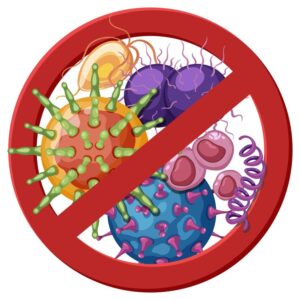A chest contamination is a disease of the lungs or aviation routes. The primary kinds of chest disease are bronchitis and pneumonia. Most bronchitis cases are brought about by infections, though most pneumonia cases are because of microorganisms.
These contaminations are generally spread when a tainted individual hacks or wheezes. This dispatches minuscule drops of liquid containing the infection or microorganisms high up, where they can be taken in by others.
The contaminations can likewise be spread to other people on the off chance that you hack or wheeze onto your hand, an item or a surface, and another person shakes your hand or contacts those surfaces prior to contacting their mouth or nose.

Certain gatherings have a higher gamble of creating serious chest contaminations, for example,
- infants and extremely small kids
- kids with formative issues
- individuals who are exceptionally overweight
- older individuals
- pregnant ladies
- individuals who smoke
- individuals with long haul ailments, like asthma, coronary illness, diabetes, kidney sickness, cystic fibrosis or ongoing obstructive pneumonic infection (COPD)
- individuals with a debilitated safe framework – this could be because of a new sickness, a transfer, high-portion steroids, chemotherapy or a medical issue, like an undiscovered HIV contamination.
The treatment for bacterial infections varies based on the specific infection and its severity. Here’s a general overview of treatments for different bacterial infections affecting various parts of the body:
A) Chest Infections/Pneumonitis (Pneumonia):
A respiratory illness known as pneumonia causes inflammation in one or both of the lungs’ air sacs. Breathing difficulties, fever, chills, and a cough with phlegm or pus are some of the symptoms that can occur when the air sacs fill with fluid or pus. Numerous microbes, such as bacteria, viruses, and fungus, can cause pneumonia.
Antibiotics are the primary treatment for bacterial pneumonia. The choice of antibiotics depends on the suspected pathogen and the severity of the infection.
Common antibiotics include macrolides, fluoroquinolones (such as levofloxacin), or cephalosporins (like ceftriaxone).
Treatment duration and choice of antibiotics may be adjusted based on the patient’s response to treatment and the results of any cultures or tests performed.
B) Chlamydia (Sexually Transmitted Infection):
Chlamydia is a common sexually transmitted infection (STI) caused by the bacterium Chlamydia trachomatis. It is one of the most prevalent bacterial STIs globally, and it can affect both men and women. Chlamydia is primarily transmitted through sexual contact (vaginal, anal, or oral) with an infected person.
Chlamydia is frequently treated with anti-infection agents like azithromycin or doxycycline. Treatment typically involves a single dose or a short course of antibiotics.
Sexual partners should also be treated to prevent reinfection.
C) Ear Infections (Otitis Media):
Otitis media refers to inflammation or infection of the middle ear. This condition is common, particularly in children, but it can affect individuals of any age. There are two main types of otitis media: acute otitis media (AOM) and chronic otitis media with effusion (OME).
Antibiotics like amoxicillin or augmentin are commonly prescribed for bacterial ear infections, especially in children. Ear drops containing antibiotics might also be used for outer ear infections (otitis externa).
D) Sinus Infections (Sinusitis):
Sinusitis refers to the inflammation or swelling of the tissue lining the sinuses. The sinuses are hollow spaces in the skull located around the nose, eyes, and cheeks. When the sinuses become inflamed, they can block the normal flow of mucus, leading to a buildup of fluid and causing symptoms. Sinusitis can be acute (short-term) or chronic (lasting for an extended period).
Antibiotics, such as amoxicillin, augmentin, or doxycycline, might be prescribed if a bacterial infection is suspected. Treatment duration may vary based on severity.
E) Skin Infections (Cellulitis, Impetigo):
Cellulitis is a bacterial skin infection that can occur when bacteria enter the skin through a cut, crack, or break in the skin barrier. It often affects the deeper layers of the skin and the underlying tissues. Common bacteria responsible for cellulitis include Staphylococcus and Streptococcus species. Impetigo is a highly contagious bacterial skin infection that primarily affects infants and children. It is caused by either Staphylococcus aureus or Streptococcus pyogenes bacteria.
Impetigo often presents as red sores or blisters that can burst and develop a yellowish crust. It is commonly found around the nose and mouth but can occur on other areas of the body.
Skin infections caused by bacteria often respond to oral antibiotics such as dicloxacillin, cephalexin, or clindamycin.
Severe cases might require intravenous antibiotics in a hospital setting.
F) Larynx Infections (Laryngitis):
Laryngitis is the inflammation of the larynx, which is the voice box located in the throat. This condition often results in hoarseness or a complete loss of voice. Laryngitis can be acute (short-term) or chronic (lasting for an extended period).
Bacterial laryngitis is less common and often resolves without antibiotics. Resting the voice and staying hydrated are typical recommendations.
If bacterial infection is severe or persistent, antibiotics like azithromycin might be prescribed.
G) Endocrine System Infections:
Infections of the endocrine system refer to conditions where microorganisms, such as bacteria, viruses, or fungi, invade and cause inflammation within the endocrine glands or related structures. The endocrine system is a complex network of glands that produce and secrete hormones, regulating various physiological processes in the body. While the endocrine glands are not as commonly susceptible to infections as some other systems, they can be affected by inflammatory processes that may be infectious in nature.
`Here are a few examples of endocrine-related infections:
Thyroiditis: Inflammation of the thyroid gland, often caused by infections or autoimmune disorders.
Adrenalitis: Inflammation of the adrenal glands, which can be due to infections, autoimmune conditions, or bleeding into the glands.
Pituitary Infections: Infections affecting the pituitary gland, a small but crucial endocrine organ at the base of the brain.
Pancreatitis: Inflammation of the pancreas, which is involved in both endocrine and digestive functions.
Hypophysitis: Inflammation of the pituitary gland, often associated with autoimmune processes but can also have infectious causes.
These infections can result from direct invasion of the glands by pathogens or may be secondary to systemic infections spreading through the bloodstream. In some cases, the immune system’s response to an infection can also lead to inflammation of the endocrine glands.
Infections affecting the endocrine system are rare, but if bacterial infection is suspected, treatment would involve antibiotics targeting the specific bacteria identified.
Mycobacterium avium Complex (MAC) Infection:
MAC infections, particularly in individuals with HIV, are treated with a combination of antibiotics, often including macrolides (like azithromycin or clarithromycin), ethambutol, rifampin, and sometimes others.
Treatment is typically prolonged and requires careful monitoring due to the complexity of the infection.
It’s crucial to note that antibiotic treatment should be prescribed and monitored by a healthcare professional. The choice of antibiotics, dosage, and duration of treatment depend on the specific bacterial infection, its severity, and any individual factors or allergies. Completing the full course of antibiotics as prescribed is essential to ensure the infection is fully treated and to prevent antibiotic resistance.
Mycobacterium avium complex (MAC) is a group of bacteria made up of two species: Mycobacterium avium and Mycobacterium intracellulare. These bacteria are found in the environment, particularly in soil and water, and can cause infections, especially in individuals with weakened immune systems, such as those with advanced HIV/AIDS.
MAC infections primarily affect people with severely compromised immune systems, typically when the CD4 cell count drops significantly in HIV/AIDS. These infections can manifest in various parts of the body, but they most commonly affect the lungs and cause a form of lung disease known as MAC lung disease or pulmonary MAC infection.
Treating MAC infections can be challenging due to the bacteria’s resistance to many antibiotics and their ability to survive within cells. The treatment regimen for MAC infections typically involves a combination of antibiotics to increase effectiveness and prevent the development of resistance. The choice of antibiotics and the duration of treatment may vary based on factors such as the severity of the infection, the individual’s immune status, and any existing drug resistance.
Macrolides: Azithromycin and clarithromycin are often the cornerstone of treatment for MAC infections. They are used in combination with other antibiotics to increase their effectiveness.
It’s important to adhere strictly to the prescribed treatment regimen to ensure the best possible outcome and to prevent the recurrence of MAC infections, especially in individuals with HIV/AIDS. Due to the complexity of these infections, treatment decisions should be made in consultation with healthcare providers experienced in managing MAC infections in immunocompromised individuals



